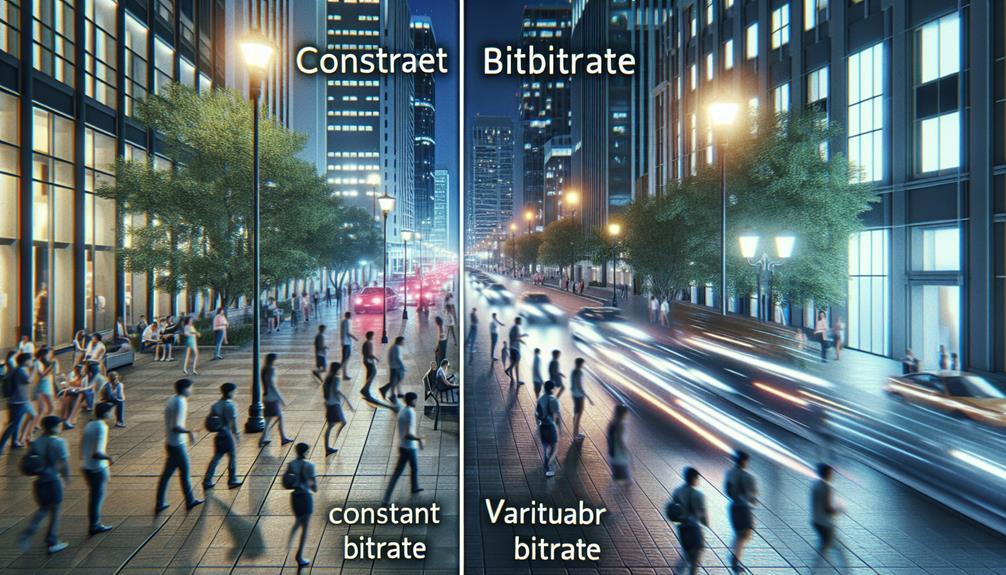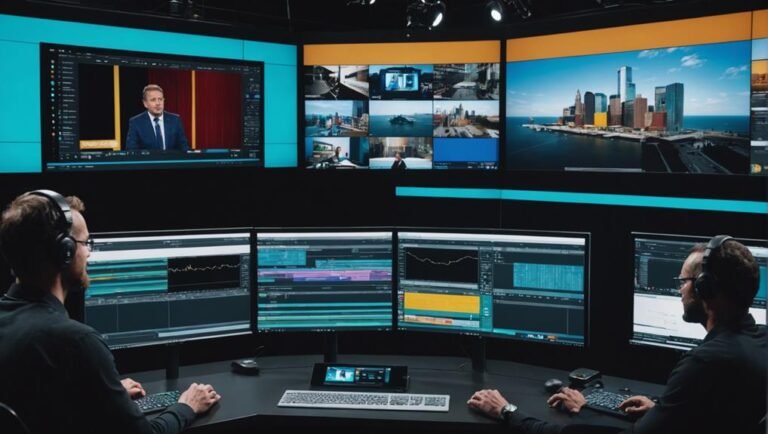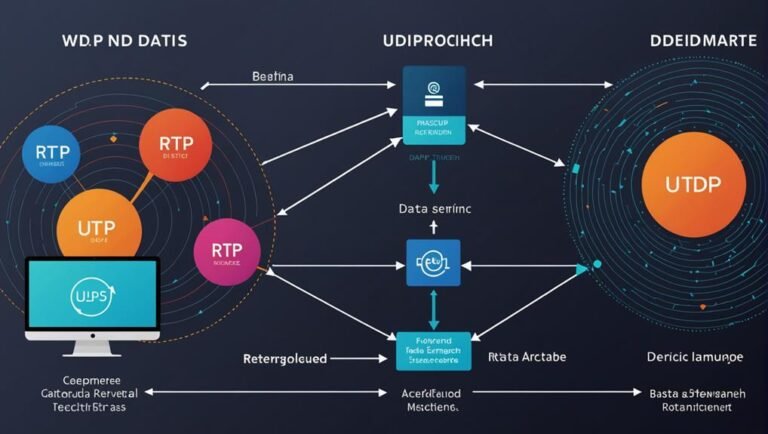Choosing between Constant Bit Rate (CBR) and Variable Bit Rate (VBR) for your CCTV system is important. CBR guarantees consistent video quality with a fixed data rate, making storage and network planning simpler. On the other hand, VBR adjusts the data rate based on scene complexity, providing better quality in high-motion scenes and saving bandwidth during simpler scenes. CBR is ideal for predictable data usage, while VBR offers flexibility and optimized quality. Understanding the trade-offs will help you set up a robust CCTV system tailored to your needs. There’s more to take into account when making your decision.
Understanding CBR Encoding
CBR encoding, or Constant Bit Rate encoding, guarantees that your CCTV system uses a fixed amount of data for each second of video footage. This means you’ll always know how much storage you need, giving you the freedom to plan and manage your storage resources effectively. With CBR, your footage quality stays consistent because the data rate remains stable, regardless of the complexity or movement in the scene.
By opting for CBR encoding, you gain the control to avoid unexpected spikes in data usage, which could lead to storage shortages or additional costs. This predictability is a huge advantage if you’re running a tight ship and need to make sure everything stays within your budget. Plus, you won’t have to constantly monitor or adjust settings, freeing up your time for more important things.
In a world where surprises can be costly, CBR encoding provides a straightforward, reliable solution. It’s perfect for those who value consistency and simplicity in their surveillance setup. You’ll appreciate the peace of mind that comes with knowing exactly what to expect regarding data usage and storage needs.
Understanding VBR Encoding
VBR encoding, or Variable Bit Rate encoding, adjusts the amount of data used based on the complexity and movement within the scene, offering more flexibility and potentially better quality footage. When you use VBR, the bit rate dynamically changes to match the demands of the video content. For scenes with lots of motion or intricate details, VBR will allocate more data to maintain clarity. Conversely, for simpler scenes, it uses less data, conserving bandwidth and storage.
You’ll appreciate how VBR adapts to what’s happening in real-time, giving you the freedom to get the most out of your CCTV system. This adaptability guarantees that critical moments with high activity are captured in greater detail without wasting resources on static, low-action scenes. It’s a smart way to balance quality and efficiency.
Advantages of CBR
While VBR offers flexibility, you’ll find that a Constant Bit Rate (CBR) approach provides consistent data usage, guaranteeing a predictable and steady flow of information. This reliability can be vital when you’re managing network bandwidth and storage. With CBR, you won’t experience the fluctuating data rates that come with VBR, making it easier to estimate your storage needs and maintain smooth network performance.
Imagine having a CCTV system that demands the same amount of bandwidth at all times. You won’t have to worry about sudden spikes that could congest your network or lead to dropped frames. CBR simplifies planning and resource allocation, giving you peace of mind knowing exactly how much bandwidth your system will use.
Moreover, CBR allows for easier troubleshooting. When issues arise, you can quickly pinpoint problems without sifting through variable data rates. This straightforward approach means less time spent on maintenance and more time enjoying the freedom that comes with a reliable system.
In addition, CBR ensures uniform video quality. You’ll get consistent footage quality regardless of scene complexity, making it ideal for environments where detail consistency is essential. For those who value reliability and predictability, CBR stands as a solid choice.
Advantages of VBR
In contrast, Variable Bit Rate (VBR) offers the flexibility to adjust bandwidth usage based on the complexity of the video content, optimizing both storage and network resources. Imagine capturing a lively scene with lots of movement—VBR ramps up the bit rate to guarantee you don’t miss any details. Conversely, during periods of inactivity, it lowers the bit rate, conserving bandwidth and saving storage space. This dynamic adjustment means you can achieve higher quality footage without unnecessary data waste.
You’ll find that VBR is particularly beneficial if you want to maximize the efficiency of your surveillance system. It’s perfect for environments with fluctuating activity levels, like a busy office during the day that quiets down at night. By allocating resources where they’re needed most, VBR helps you maintain a balance between video quality and data usage.
Moreover, VBR enhances your network’s performance. Since it only uses high bit rates when necessary, you’ll experience fewer bottlenecks and reduced latency. This means smoother, more reliable video streams. If you value flexibility and efficiency, VBR is a solid choice for your CCTV system, ensuring you capture clear, detailed footage while optimizing your resources.
Drawbacks of CBR
Despite the benefits of VBR, Constant Bit Rate (CBR) comes with its own set of limitations that can impact the efficiency and quality of your CCTV system. First and foremost, CBR doesn’t adapt to the complexity of the scene being recorded. This means you’ll use the same amount of bandwidth for both simple and complex scenes, which isn’t efficient. If your scenes vary greatly, this could lead to wasted resources and unnecessary costs.
Another significant drawback is the potential for reduced video quality during complex scenes. Because CBR maintains a fixed bit rate, it might not allocate enough bandwidth for scenes with a lot of movement or detail. As a result, you could experience pixelation or blurriness, compromising the quality of your footage when it matters most.
Additionally, CBR can put a strain on your storage capacity. Since it uses a consistent bit rate, you can’t take advantage of lower bit rates during less demanding scenes, leading to larger file sizes and quicker depletion of storage space. This can force you to invest in more storage than you might actually need, limiting your freedom to allocate resources elsewhere.
Drawbacks of VBR
Even though Variable Bit Rate (VBR) offers flexibility, it comes with its own set of challenges that can complicate your CCTV system. One major issue is unpredictability. Since VBR adjusts the bit rate based on the complexity of the footage, you might experience fluctuating video quality. During times of high activity, the bit rate spikes, potentially overwhelming your network and causing lag or dropped frames. This inconsistency can be frustrating, especially when you need reliable surveillance.
Moreover, VBR can complicate bandwidth management. You might think you’re saving bandwidth during low-activity periods, but when activity increases, the sudden demand can strain your network. This unpredictability makes it harder to plan and allocate resources effectively.
Another drawback is the potential for higher processing demands. Your system has to constantly analyze footage and adjust the bit rate, which can tax your hardware. If your system isn’t robust enough, you could face performance issues, leading to gaps in critical surveillance footage.
Lastly, troubleshooting becomes more complex with VBR. When issues arise, it’s harder to pinpoint whether the problem stems from bit rate fluctuations, network strain, or hardware limitations, complicating maintenance and repairs.
Storage Considerations
Given the challenges of VBR, it’s important to contemplate how these bit rate fluctuations impact your storage needs. VBR, or Variable Bit Rate, means that your recorded footage will vary in size depending on the scene’s complexity. While this approach can save storage during low-motion scenes, it can also lead to sudden spikes when the action picks up. This unpredictability can make it difficult to estimate how much storage you’ll need over time.
You’ve got the freedom to choose between VBR and CBR (Constant Bit Rate), but each has its storage implications. With CBR, you get a predictable, consistent file size, making storage planning straightforward. You won’t need to worry about sudden increases in storage requirements, giving you peace of mind. However, CBR might use more storage overall since it doesn’t adjust to scene complexity.
If you value flexibility and want to optimize storage, VBR might be appealing. You’ll save space when possible, but you’ll need to monitor storage usage closely and be prepared for unexpected demands. Balancing these factors is key to making an informed choice that aligns with your priorities and freedoms.
Network Impact
Choosing between CBR and VBR for your CCTV system has a substantial impact on your network’s performance and reliability. With CBR (Constant Bit Rate), you’re ensuring a steady, predictable flow of data. This means you won’t have to worry about sudden spikes in bandwidth usage. It’s easier to manage and plan your network capacity, giving you the freedom to run other network-dependent operations without unexpected interruptions.
On the other hand, VBR (Variable Bit Rate) can offer greater flexibility but at a cost. With VBR, your system adjusts the bit rate based on the complexity of the footage, which can lead to fluctuating bandwidth demands. If your network isn’t robust enough, you might experience congestion or lag, affecting not just your CCTV but other network services as well. However, this could be a viable option if your network has ample capacity and you want to optimize storage and quality dynamically.
Ultimately, your choice affects your network’s overall health. With CBR, you gain predictability and ease of management. With VBR, you get efficiency and potential savings but need a reliable, flexible network. Reflect on your current network’s capabilities and your priorities to make the best decision.
Quality Comparison
While network impact is a significant consideration, the choice between CBR and VBR also influences the visual quality of your CCTV footage. With CBR (Constant Bit Rate), your footage maintains a uniform bit rate, meaning the quality stays consistent regardless of the scene’s complexity. This can be a blessing if you’re after predictability and uniformity in your recordings. You’ll avoid the pitfalls of fluctuating quality, ensuring that every critical moment is captured clearly.
On the flip side, VBR (Variable Bit Rate) dynamically adjusts the bit rate based on the scene’s complexity. When there’s more motion or detail, VBR ramps up the bit rate to preserve the quality. Conversely, in simpler scenes, it reduces the bit rate, saving storage space and bandwidth. This flexibility can lead to superior visual quality, especially in high-motion environments where details matter most. However, you might notice variations in quality during less complex scenes.
Ultimately, while CBR offers consistency, VBR provides flexibility and potentially higher quality when needed. Your choice will depend on what you prioritize more: a steady, predictable quality or the freedom to adapt and maximize visual clarity when it counts.
Choosing the Right Method
When deciding between CBR and VBR for your CCTV system, consider your specific needs and priorities. CBR, or Constant Bit Rate, is perfect if you need predictable data usage. It offers a steady stream of data, making it easier to manage storage and bandwidth. If your priority is to make sure that your system doesn’t max out your network or storage capacity, CBR is your go-to.
On the other hand, VBR, or Variable Bit Rate, gives you flexibility and optimized quality. It adjusts the data rate based on the scene’s complexity, providing higher quality when needed and saving bandwidth during less demanding scenes. If you want the freedom to capture high-quality footage without worrying about wasting storage on simple scenes, VBR is ideal.
Think about what matters more to you: consistent data management or maximum video quality. Your choice between CBR and VBR should align with your goals, whether it’s guaranteeing reliable performance or achieving the best possible footage. Remember, there’s no one-size-fits-all answer. Your decision should empower you to get the most out of your CCTV system while aligning with your unique requirements.
Frequently Asked Questions
What Does CBR and VBR Stand for in CCTV Terminology?
Imagine CCTV footage like a river. CBR (Constant Bit Rate) is a steady flow, always consistent. VBR (Variable Bit Rate) is a wild, untamed stream, adjusting its pace based on the scene’s complexity.
How Does VBR Impact Real-Time Monitoring in CCTV Systems?
VBR enhances your real-time monitoring experience by adjusting the bitrate based on scene complexity. You’ll get higher quality video during fast movements and save bandwidth during static scenes, giving you freedom and flexibility.
Are There Specific CCTV Camera Brands That Support Both CBR and Vbr?
Imagine soaring like a bird with no boundaries; some CCTV camera brands, like Hikvision and Dahua, offer both CBR and VBR. They give you the freedom to choose how you want to monitor your security.
Can CBR and VBR Settings Be Adjusted Remotely in Modern CCTV Systems?
Yes, you can adjust CBR and VBR settings remotely in modern CCTV systems. With user-friendly interfaces and remote access capabilities, you’ve got the freedom to tweak your settings anytime, anywhere, ensuring peak performance.
Do CBR and VBR Encoding Methods Affect Night Vision Recording Quality?
Crystal-clear clarity counts! You’ll notice that night vision recording quality can indeed be influenced by encoding methods. Choosing the right one gives you freedom to capture crisp, clear footage even in the darkest conditions.



